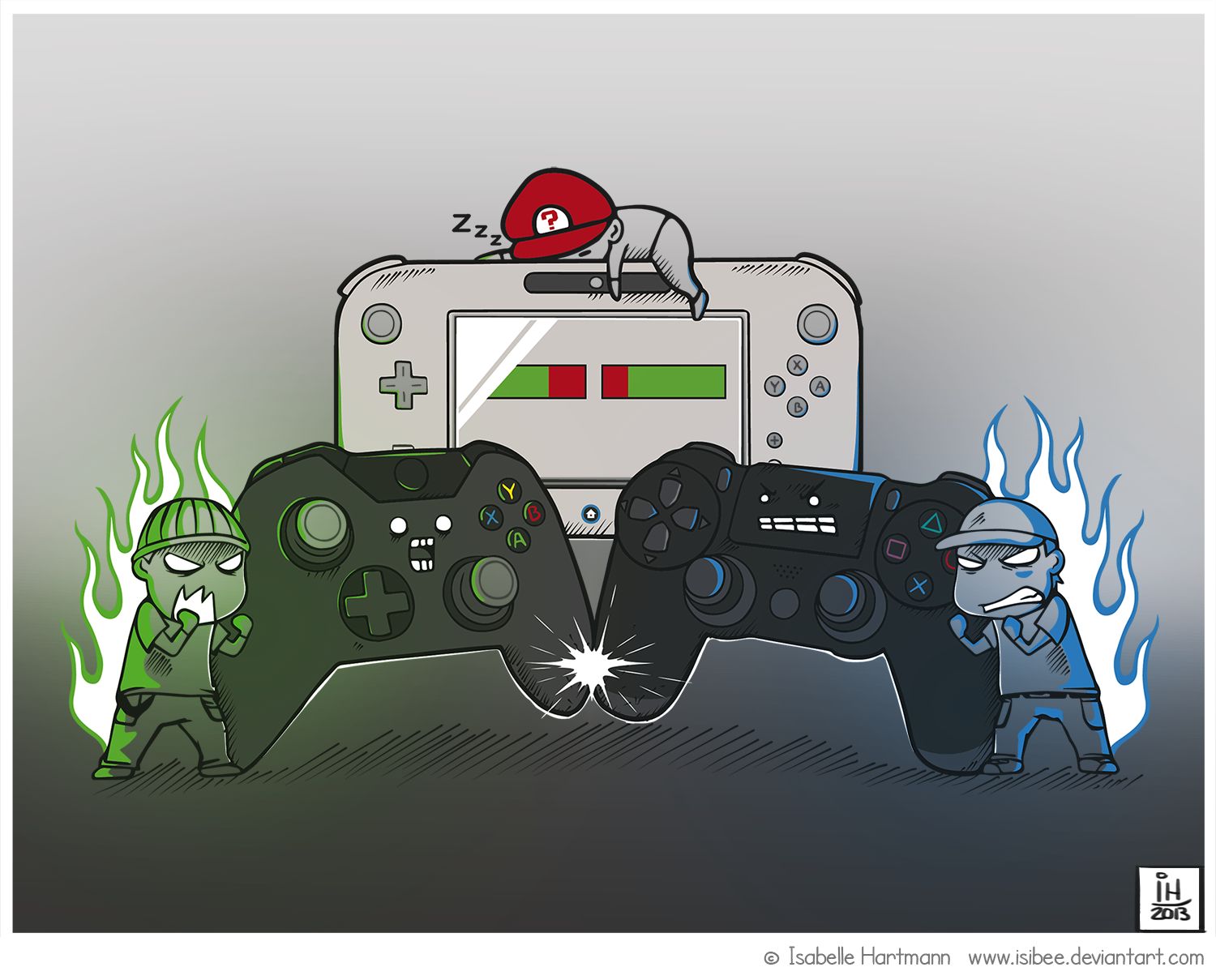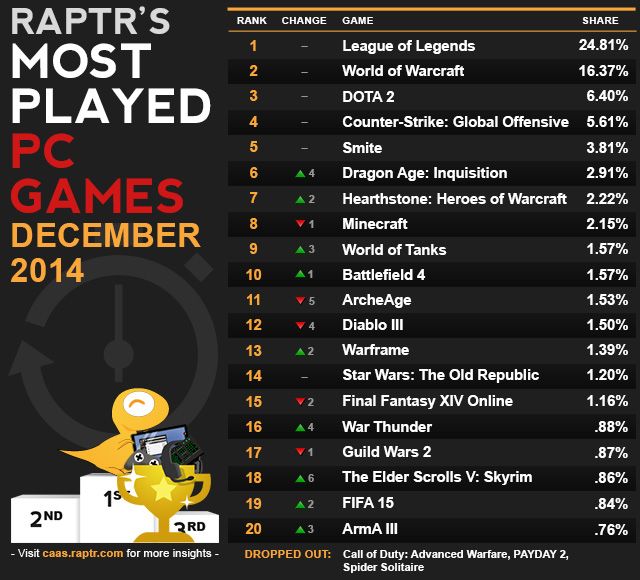NPD has delivered its report covering December 2014, and also provided data for the full year of US retail sales of video games and accessories. The bottom line is that while hardware sales have been terrific for the year, up 20 percent overall versus 2013 ($5.07 billion versus $4.24 billion), software at retail stores dropped by 13 percent to $5.3 billion from $6.11 billion in 2013 (if you include PC software, the drop was 14 percent) as consumers increasingly moved to digital purchases. December was rougher for hardware, down by 4 percent to $1.31 billion from last year’s $1.37 billion, while software as down to $1.25 billion from December 2013’s $1.28 billion.
NPD’s Liam Callahan, as usual, looked for the bright side of the results. “For 2014, a modest 1 percent increase in overall sales was fueled almost entirely by the $838 million increase in hardware sales, offsetting the $808 million decline in software, however. Accessories grew by $132 million, leading to the 1 percent growth in overall retail sales,” Callahan said. He proceeded to put the results in context: “Keep in mind that the results for December and 2014 as a whole show the console space is going through a period of two transitions: One being a generational transition from seventh generation to eighth generation consoles and second, a format transition as console gamers become more comfortable with downloading games and what is being offered digitally.”
The interesting part is that NPD’s retail sales information is becoming increasingly less useful as the percentage of game software purchased at retail continues to decline. As SuperData’s CEO Joost van Dreunen noted, the retail software sales and digital software sales totals are about the same — though of course that’s largely due to mobile games and PC online games, which don’t have much impact at retail (though there are some digital value cards sold at retail). The bright spot for publishers has to be the continued strong sales of consoles, which means a greater installed base that may buy games. Still, it’s not going to be easy, with plenty of smaller, lower-priced indie games doing better than ever on consoles, and all of the forces at work changing the very nature of AAA console titles.
The hardware side of the market had a very good month, at least as far as next-gen consoles are concerned. “After 14 months on the market, cumulative sales of PS4 and Xbox One exceed the Xbox 360 and PS3 cumulative 14 month total by 65 percent,” Callahan noted. Of course, this is also a reflection of the weak sales of the seventh-generation consoles, which continue to disappoint.
Microsoft and Nintendo both weighed in with statements about how their consoles performed. “Wii U established new benchmarks for hardware and software sales in a single month in December,” said Nintendo in a statement. “This helped total hardware and software sales in 2014 increase by more than 29 percent and more than 75 percent, respectively, over sales in 2013.” Nintendo did not, however, supply any unit numbers, no doubt to forestall direct comparisons with other consoles.
Microsoft claimed the crown of console sales leader yet again. “Xbox One ended 2014 with an unprecedented holiday season, becoming the best-selling console in the U.S. in November and December,” said Microsoft in a statement. “In fact, weekly average sales during these months outpaced Xbox 360 by 50 percent at the same point in its lifecycle.” In a not-coincidental move, Microsoft once again dropped the price of the Xbox One by $50 to $349, after the price rose to $399 on January 1 with the end of its holiday promotion.
Once again, Microsoft is billing this as a promotional price rather than an actual, honest-to-retail MSRP price reduction. “We are excited to announce a new promotion in which fans in the U.S. can buy an Xbox One at a special price of $349, starting tomorrow, January 16, from their preferred retailer,” said Mike Nichols, Corporate Vice President of Marketing for Xbox. It’s difficult to avoid the inference that sales plummeted like a paralyzed falcon once the price went back up January 1, and Microsoft was not about to let Sony regain any momentum here. No end date for the promotion was announced… but it would be stunning if the price ever went up again from this point. It’s also not clear yet whether this price drop is worldwide, though that seems likely.

Sony weighed in by pointing out that they were still in the lead in overall consoles installed. “PlayStation 4 was the top-selling console in the U.S. and globally in 2014,” a Sony Computer Entertainment America spokesperson told GamesBeat. “And [it is] the fastest selling console in PlayStation history with 18.5 million sold through after just 14 months in the market. We are humbled by this success and want to thank gamers worldwide for helping us achieve holiday sales of more than 4.1 million across 123 countries and regions. We are looking forward to another momentous year in 2015 and bringing an epic line up of titles to PlayStation fans around the world.”
Callahan provided more detail about hardware sales over the holidays, and it shouldn’t surprise anyone to learn that bundling software helps move hardware. “Bundles were a major driver of hardware sales this December compared to last with 71 percent of hardware unit sales stemming from Bundles including software, which compares to 32 percent of hardware sales last December,” Callahan noted.
The software picture was a mixed one, as gains by eight-generation console software sales were more than offset by the drop in seventh-generation and handheld software sales. “With the growth in install bases across eighth generation consoles, software this December versus last December grew by 70 percent with each console posting strong double digit growth,” Callahan said. “Across 2014, eighth generation console software sales rose by $1.7 billion. In contrast, seventh generation software sales declined by 33 percent in December with portable sales also decreasing 16 percent. These combined to total a $2.5 billion decrease in sales in 2014 versus 2013.”
Interestingly, the lion’s share of the software sales went to the big cats sitting at the top of the charts. “While overall software sales dipped by 2 percent in December, top 10 represented the same percentage of unit sales as last December at 36 percent of all units sold in the month with only 1 percent fewer units,” Callahan stated. “Part of the 13 percent decline in entertainment software sales can be explained by 10 percent fewer new SKUs that were launched in 2014 compared to 2013.”
December 2014 Top 10 Games (US retail, across all platforms)
1. Call of Duty: Advanced Warfare (360, XBO, PS4, PS3, PC)** Activision Blizzard
2. Grand Theft Auto V (XBO, PS4, 360, PS3)** Take 2 Interactive
3. Madden NFL 15 (360, XBO, PS4, PS3)** Electronic Arts
4. Super Smash Bros. (NWU, 3DS)** Nintendo
5. NBA 2K15 (360, XBO, PS4, PS3, PC) Take 2 Interactive
6. Minecraft (360, XBO, PS3, PS4) Microsoft / Sony
7. Far Cry 4 (PS4, XBO, 360, PS3, PC)** Ubisoft
8. Just Dance 2015 (Wii, 360, NWU, XBO, PS4, PS3) Ubisoft
9. Destiny (XBO, 360, PS4, PS3)** Activision Blizzard
10. FIFA 15 (360, XBO, PS4, PS3, Wii, 3DS, PSV)** Electronic Arts
NPD also released its annual list of the top-selling games at US retail stores for 2014, and there weren’t many surprises. If it wasn’t for the purchase of Mojang by Microsoft, we would have seen a company that’s not one of the big publishers grab a spot in the top ten . . . but you can see why Microsoft made the purchase by that very fact. It’s interesting that neither Skylanders nor Disney Infinity made the list, but those titles are doing quite well with the added revenue from the toy sales counted in. Destiny did amazingly well for a brand new IP, and it will be interesting to see how it performs in 2015. Destiny along with Watch Dogs were the only new IPs to make it onto the Top Ten list. Will 2015 end up having more or fewer new IPs in the Top Ten list That will be interesting to watch.
Annual 2014 Top 10 Games (US retail, across all platforms)
1. Call of Duty: Advanced Warfare (360, XBO, PS4, PS3, PC)** Activision Blizzard
2. Madden NFL 15 (360, PS4, XBO, PS3)** Electronic Arts
3. Destiny (XBO, PS4, 360, PS3)** Activision Blizzard
4. Grand Theft Auto V (PS4, XBO, 360, PS3)** Take 2 Interactive
5. Minecraft (360, PS3, XBO, PS4) Microsoft / Sony
6. Super Smash Bros.(3DS, NWU)** Nintendo
7. NBA 2K15 (PS4, XBO, 360, PS3, PC) Take 2 Interactive
8. Watch Dogs (PS4, XBO, 360, PS3, PC, NWU)** Ubisoft
9. FIFA 15 (360, PS4, XBO, PS3, Wii, 3DS, PSV)** Electronic Arts
10. Call Of Duty: Ghosts (360, PS3, XBO, PS4, NWU, PC)** Activision Blizzard
**(includes CE, GOTY editions, bundles, etc. but not those bundled with hardware)



